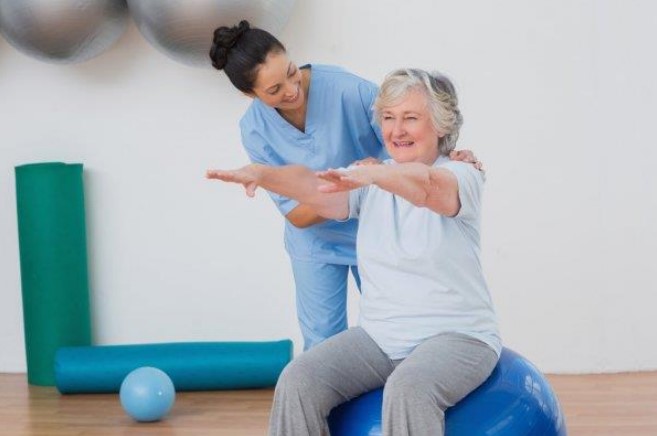Amyotrophic Lateral Sclerosis (ALS), also called Lou Gehrig’s disease, slowly damages the nerve cells that control muscles. This makes it harder to move, speak, and eventually breathe. While physiotherapy cannot stop the disease but the physiotherapy management of als can make life easier and more comfortable for the person by helping them stay as mobile and independent as possible for as long as they can.

Physiotherapy is a key part of helping people with ALS live better. As ALS affects the muscles, physiotherapy focuses on keeping the body as active and comfortable as possible for as long as possible.
Goals of Physiotherapy management in Als
- Maintain movement and muscle strength
– Help the person stay mobile and avoid losing muscle use too quickly. - Prevent stiffness and joint problems
– Regular movement keeps joints flexible and avoids contractures (permanent stiffness). - Support breathing
– Strengthening chest muscles and teaching breathing exercises can slow down respiratory problems. - Ease pain and reduce tiredness
– Gentle exercises and good body positioning can relieve discomfort and avoid fatigue. - Promote safety and independence
– Teaching safer ways to move and use assistive devices helps avoid falls and injuries. - Educate family and caregivers
– Provide training to help loved ones care safely and effectively.
Stages of Physiotherapy Management of Als
Early Stage – Staying Active with Minimal Help
At this stage, the person might notice some muscle weakness, but can still do most daily tasks.
Physiotherapy Techniques:
- Active stretching – Stretch arms, legs, and neck to avoid muscle tightness.
- Mild strengthening – Focus on muscles that are still strong. Use light resistance and avoid over-exertion.
- Gentle aerobic exercises – Short walks, cycling, or swimming to keep the heart and lungs healthy.
- Balance training – To reduce the risk of falls.
- Posture education – Teaching correct sitting and standing posture to avoid pain and fatigue.
Middle Stage – Increasing Support and Energy Conservation
As the disease progresses, weakness becomes more noticeable, especially in the arms and legs.
Physiotherapy Techniques:
- Use of assistive devices – Such as:
- Canes or walkers for balance
- AFOs (ankle-foot orthoses) for foot drop
- Wheelchairs when walking becomes difficult
- Stretching and passive ROM – The therapist or caregiver may help move joints to keep them from becoming stiff.
- Breathing exercises – Use of breathing tools (e.g., incentive spirometry) to maintain lung function.
- Energy-saving techniques – Teach how to do tasks more efficiently (e.g., sit while dressing or cooking).
- Home safety adjustments – Recommend changes like grab bars, ramps, or non-slip mats.
Late Stage – Comfort and Supportive Care
In this stage, the person may have limited movement and rely on a wheelchair or be bedridden.
Physiotherapy Techniques:
- Passive movements – The physiotherapist or caregiver moves the person’s arms and legs to avoid joint stiffness and pain.
- Positioning techniques – Frequent turning in bed to avoid pressure sores. Use of cushions and special mattresses.
- Chest physiotherapy – Includes:
- Postural drainage to remove mucus
- Manual cough assistance or machines to help clear secretions
- Respiratory support education – Teach how to manage breathing problems with non-invasive ventilation if needed.
- Support for caregivers – Teach proper lifting, transferring, and handling techniques to reduce injury risk.
Multidisciplinary Care:
Physiotherapists often work with:
- Occupational Therapists (OTs): Help with home modifications, adaptive tools, and daily activities.
- Speech Therapists: Assist with speech and swallowing issues.
- Respiratory Therapists: Guide breathing exercises and use of ventilatory support.
Helpful Tips for ALS Physiotherapy:
- Avoid tiring the patient – exercises should be gentle and short.
- Focus on function over fitness – the goal is to keep the person independent, not necessarily stronger.
- Monitor fatigue – ALS patients can get tired easily. Watch for signs like slower movement, slurred speech, or shortness of breath.
- Encourage fun, safe movement – use music, games, or group exercises if possible to keep the patient engaged.
- Keep regular sessions – consistent therapy helps slow decline.
What is the main goal of physiotherapy in ALS?
To help maintain mobility, comfort, and independence for as long as possible by managing symptoms like muscle weakness, joint stiffness, and breathing difficulties.
How does physiotherapy change across the stages of ALS?
In early stages, it focuses on mild strengthening and posture; in middle stages, it includes assistive devices and energy conservation; in late stages, it emphasizes comfort, positioning, and respiratory support.
Why is caregiver education important in ALS physiotherapy?
Because caregivers play a key role in safe movement, handling, and daily care, especially in advanced stages where the patient becomes highly dependent.

